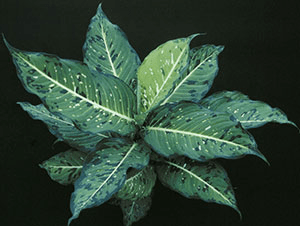Dieffenbachia
The UF/IFAS Assessment of Non-Native Plants in Florida’s Natural Area’s recently predicted dieffenbachia to be invasive in Florida and is no longer recommended by UF/IFAS Extension.

Dieffenbachia is an incredibly easy-to-grow houseplant. Popular since the Victorian era, dieffenbachia is an attractive, tropical indoor plant.
Characteristics
Depending on the cultivar, the thick, large leaves are usually some mixture of green, white, and yellow. Dieffenbachias come in a number of cultivars with different sizes, colors, and variegation patterns.
There are many compact forms that rarely need to be cut back, growing to only 12 inches tall; they make wonderful accent plants and some are low-growing enough to be used as tall groundcovers.
Other cultivars can grow to be quite large, reaching 6 to 8 feet or more in height. The taller varieties should be pruned back occasionally to encourage a fuller form.
Dieffenbachias produce flowers seasonally, though they seldom flower indoors, and the blooms are not showy.
Planting and Care
Dieffenbachia prefers diffused sunlight or partial shade, but will tolerate full shade, which is why it is well-suited as a houseplant. It thrives in temperatures between 60 and 75°F.
Your dieffenbachia should be watered regularly, with soil being allowed to dry between waterings. It can be planted in any good quality, well-drained potting media and should be repotted as needed to allow for best growth. Dieffenbachia’s preference for relatively high humidity makes it a great option for Florida. To encourage even growth, turn your plant often.
Use caution with this plant if you have small children or curious pets, as its sap has toxic qualities which can cause tongue and throat swelling when ingested.
Troubleshooting
If your dieffenbachia isn’t looking as healthy as it once did, there are some easy ways to troubleshoot your problems.
Leaf Problems
- Leaves are droopy — Droopy leaves can by caused by too little water. When the soil surface is dry to the touch, water your plant well, water again when the soil surface becomes dry. If the leaves droop and fall without yellowing first, your plant may be too cold. Move your plant to an area where the temperature will not fall below 55 degrees. The lowest leaves may turn yellow and begin to droop as part of the plant’s normal growth pattern. Simply remove the drooping leaves as part of your regular up-keep.
- Leaves have brown tips — Brown tips on your dieffenbachia’s leaves could be caused by uneven watering. Keep your watering practices a little more regular and never let your plant sit in water.
- Leaves are curled with brown edges — Curled, browning leaves could be caused by excessive fertilizer application. Flush away accumulated salts and fertilizer with clean water. Follow label instructions for correct fertilizer application rates.
Growth issues
- Uneven growth — Uneven growth occurs when dieffenbachia stretches toward a light source. To even out the growth of your dieffenbachia, turn your plant a quarter turn every few days.
- Little new growth — If the growth of your dieffenbachia has slowed or stopped it is likely not receiving enough light. Move your plant to a brighter location and consider feeding your plant a high-nitrogen foliage plant food as recommended.
Pests

- Cottony masses on your plant — Cottony masses on stems and the undersides of leaves signify the presence of mealybugs. To treat your dieffenbachia, apply a labeled product at the recommended rates. Be sure to follow all label instructions.
- Pale leaves and a webby material on leaf undersides — Spider mites may be the cause of your plant’s troubles. The first course of action is to isolate your dieffenbachia to prevent the spider mites from spreading to other plants. Mite populations can be reduced by taking the plant outside and spraying it with a forceful spray of water. Labeled pesticides may be needed for best control. Contact your local county Extension Agent for recommendations.
